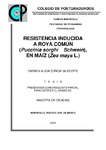Resistencia inducida a roya común (Puccinia sorghi Schwein), en maíz (Zea mays L.).
Abstract
La roya común Puccinia sorghi Schw. forma pústulas en las hojas de plantas de maíz reduciendo el área foliar y la producción de fotoasimilados necesarios para el llenado de grano. El hospedante posee genes para codificar diferentes tipos de proteínas relacionadas con los mecanismos de defensas que impiden el establecimiento del patógeno. Sin embargo, existen plantas susceptibles incapaces de evitar el ataque del patógeno. Esta condición no es una regla ya que existen factores bióticos y abióticos, conocidos como inductores de resistencia, capaces de activar los procesos físico-químicos o morfológicos de defensa para contrarrestar la invasión del fitopatógeno. El híbrido Ceres XR21 es susceptible a P. sorghi, por lo que aquí se evaluó bajo un diseño de parcelas sub-subdivididas en dos ciclos primavera-otoño en los años 2016 y 2017, en el que se compararon cinco productos comerciales reportados como inductores de resistencia: Bacillus subtillis (Serenade® Max), Bacillus firmus +clotianidin (Poncho Votivo®), Fosetil aluminio (Aliette), proteína Harpin Ea (Messenger®), Acibenzolar S metil (Actigard 50 GS) y el fungicida trifloxystrobin + tebuconazol (Consist Max®). Cada producto se aplicó en tres dosis (50, 100 y 150% de la comercial), y por dos vías: suelo y foliar. Para determinar su función como inductores de resistencia, se evaluaron parámetros agronómicos y fisiológicos. Los resultaron mostraron que trifloxystrobin + tebuconazol (Consist Max®), aplicado en follaje con el 50 % del producto adicional a la dosis recomendada comercialmente, destacó en la mayoría de variables evaluadas, pues controló mejor al patógeno P. sorghi y también aumentó la producción de grano. _______________ INDUCED RESISTANCE TO COMMON RUST (Puccinia sorghi Schwein), IN MAIZE (Zea mays L.). ABSTRACT: The common rust, caused by Puccinia sorghi Schw. forms pustules on the leaves of maize plants, reducing the foliar area and the production of photoassimilates necessary for grain filling of grains. The host posses genes to code different types of proteins, related to defense mechanisms preventing the establishment of the pathogen. However, there are susceptible plants that are uncapable of preventing pathogen attack. This condition is not a rule, as there are biotic and abiotic factors known as inducers of resistance capable of activating the physico-chemical or morphological defense processes to counteract the invasion of the pathogen. The Ceres XR21 maize hybrid is susceptible to P. sorghi, so here it was evaluated under, a split-split- plot design was established in two spring-autumn cycles in the years 2016 and 2017, in which they were compared five commercial products reported as inducers of resistance: Bacillus subtillis (Serenade® Max), Bacillus firmus + clotianidin (Poncho Votivo®), Fosetil aluminum (Aliette), Harpin Ea protein (Messenger®), Acibenzolar S methyl (Actigard 50 GS) and the fungicide trifloxystrobin + tebuconazole (Consist Max®). Each one was applied in three doses (50, 100 and 150 % of the commercial), and in two vias: soil and spray. To determine their effect as inducers of resistance, agronomic and physiological parameters were evaluated. The results showed that trifloxystrobin + tebuconazole (Consist Max®), applied on the foliage with and the dose with 50% of the product additional to that recommended commercially (150 %), showed significantly different response in most of the variables evaluated, well controlling better the pathogen P. sorghi and also increasing grain yield.
Collections
- Tesis MC, MT, MP y DC [221]


